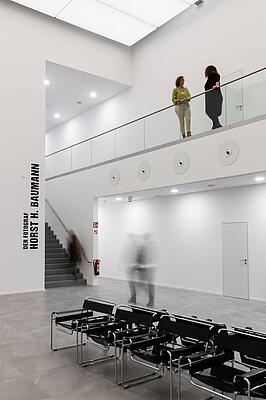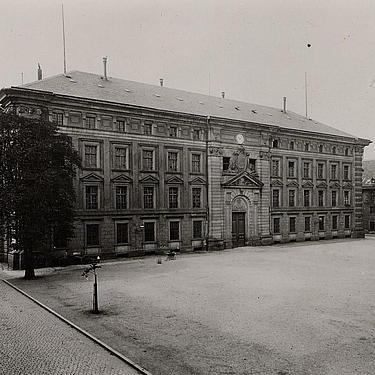Highlights of Reiss-Engelhorn-Museen History
The roots of the collections' holdings date back the day of the electors Carl Philipp and Carl Theodor in the 18th century. Today the Reiss-Engelhorn-Museen have established themselves as an internationally operating complex of museums, an outstanding venue for exhibitions and a major center of research.
Directors
1949 Ludwig W. Böhm becomes director of the Reiss-Museum, in 1962 Herbert Meyer, in 1974 Erich Gropengießer and in 1990 Karin von Welck.
In 1999 Alfried Wieczorek becomes director of the Reiss-Museum and then the Reiss-Engelhorn-Museen as of 2001. 2010 he becomes the first director general of the Reiss-Engelhorn-Museen.
2021 becomes Wilfried Rosendahl director general of the Reiss-Engelhorn-Museen.
18th century
1731
The roots of the collections’ holdings date back the day of the electors Carl Philipp and Carl Theodor. They lay the foundation for the painting gallery, the drawing and print collection, the cabinet of natural curiosities, the numismatic collection, the antiquities collection, the cabinet of scientific curiosities and the treasure chamber.
1777/78
The Zeughaus, the centerpiece of the rem, is an armory built under Elector Carl Theodor following master builder Peter Anton von Verschaffelt’s designs. It is one of the most important monuments of early German neoclassicism in the quadratic city.
![[Translate to Englisch:] Gemälde Kurfürst Carl Theodor [Translate to Englisch:] Gemälde Kurfürst Carl Theodor](/fileadmin/_processed_/f/9/csm_rem300-Therbusch_Carl_Theodor_im_Rahmen_JC_4973c290f0.jpg)
19th century
1859
The holdings of the Mannheimer Altertumsverein (Mannheim Historical Society), founded in 1859, are merged with the grand duke’s antiquarium to form the combined antiquities collections.
1868
Wilhelm Reiss embarks on his eight-year expedition through South America.
1879
Carl and Anna Reiss travel to Egypt for the first time.
1893
Their trip around the world by way of China and Japan takes them as far as North America. The Reiss siblings bring extensive assortments of travel photographs back from their travels to their hometown, which now constitute the foundation of collection of historical travel photographs of the Forum Internationale Photographie.
![[Translate to Englisch:] Pyramidenstraße, Historische Fotografie Sammlung Reiß [Translate to Englisch:] Pyramidenstraße, Historische Fotografie Sammlung Reiß](/fileadmin/_processed_/c/4/csm_BLOG_202006_Herrmann_Reise_0a62e645f6.jpg)
20th century
1905
The Stadtgeschichtliches Museum (Museum of City History) opens on L1.
1908
Mannheim’s Zeughaus is primarily used as a museum of natural history as of 1908.
1926
The Mannheimer Schlossmuseum (Mannheim Palace Museum) opens. All electoral, then, grand ducal and, finally, Baden state collections are bequeathed to the city.
1936
The Theatermuseum (Theater Museum) opens on E7.
ab 1946
The building suffered major damage in World War II. Its reconstruction commences in 1946.
1957
The Reiss Museum opens in the Zeughaus.
1988
The addition to the Reiss Museum opens on D5. The present Museum Weltkulturen (World Cultures Museum) is built following designs drafted by architect Carlfried Mutschler and artist Erwin Bechtold.
![[Translate to Englisch:] Außenansicht Museum Weltkulturen [Translate to Englisch:] Außenansicht Museum Weltkulturen](/fileadmin/_processed_/d/b/csm_Museum_Weltkulturen_aussen_01_1ce9be6d18.jpg)
21st century
2001
By resolution of the Mannheim City Council, the Reiß Museum is renamed Reiss-Engelhorn Museums in 2001 in reference to the Engelhorn founding families.
The Curt-Engelhorn-Stiftung (Curt Engelhorn Foundation) for the Reiss-Engelhorn-Museen is established.
2002
The Forum Internationale Photographie (International Photography Forum) is established.
2003
The new Curt-Engelhorn-Zentrum für Kunst- und Kulturgeschichte (Curt Engelhorn Institute Center of Art and Cultural History) is established.
2004
The Curt-Engelhorn-Zentrum Archäometrie gGmbH (Curt Engelhorn Archaeometry Center gGmbH) is founded.
2005
ZEPHYR – Raum für Fotografie is established.
2007
The Museum Zeughaus reopens after three years of complete renovation.
2008
The Bassermann-Kulturstiftung Mannheim (Bassermann Cultural Foundation Mannheim) is established.
2010
The Reiss-Engelhorn-Museen funded by the city formally receives the status of a state museum. The Klaus-Tschira-Labor für physikalische Altersbestimmung
(Klaus Tschira Physical Dating Laboratory) opens.
2011
The Museum Bassermannhaus für Musik und Kunst opens.
2012
Museum Management Mannheim GmbH (MMM) is founded.
2013
The rem gGmbH, now the rem gGmbH Stiftungmuseen, is founded. The Brombeeren-Stiftung is established.
2014
The University of Hohenheim’s dendrochronological collection is taken over by a new laboratory of the Curt-Engelhorn-Zentrum Archäometrie gGmbH.
The exhibition „Ägypten – Land der Unsterblichkeit“ (Egypt: Land of Immortality) opens. The rem’s creation of a department of ancient Egyptian art and cultural history of its own establishes a new facility for ancient Egypt in the German museum scene in Mannheim.
2016
The bioarchaeolgy unit at the Curt-Engelhorn-Zentrum Archäometrie gGmbH is expanded.
2017
The Villa Poensgen branch is established at Heidelberg University with the “Geschichte und Kulturelles Erbe” (History and Cultural Heritage) research unit. The new museum storage facility built in Mannheim-Mallau by the Brombeeren-Stiftung commences operation.
2019
The cornerstone of the Museum Peter und Traudl Engelhornhaus is laid.
2020
The renovation work on the landmarked “Raschighaus”, headquarters of the Curt-Engelhorn-Zentrum Archäometrie gGmbH, concludes.
2023
The Museum Peter & Traudl Engelhornhaus opens.

